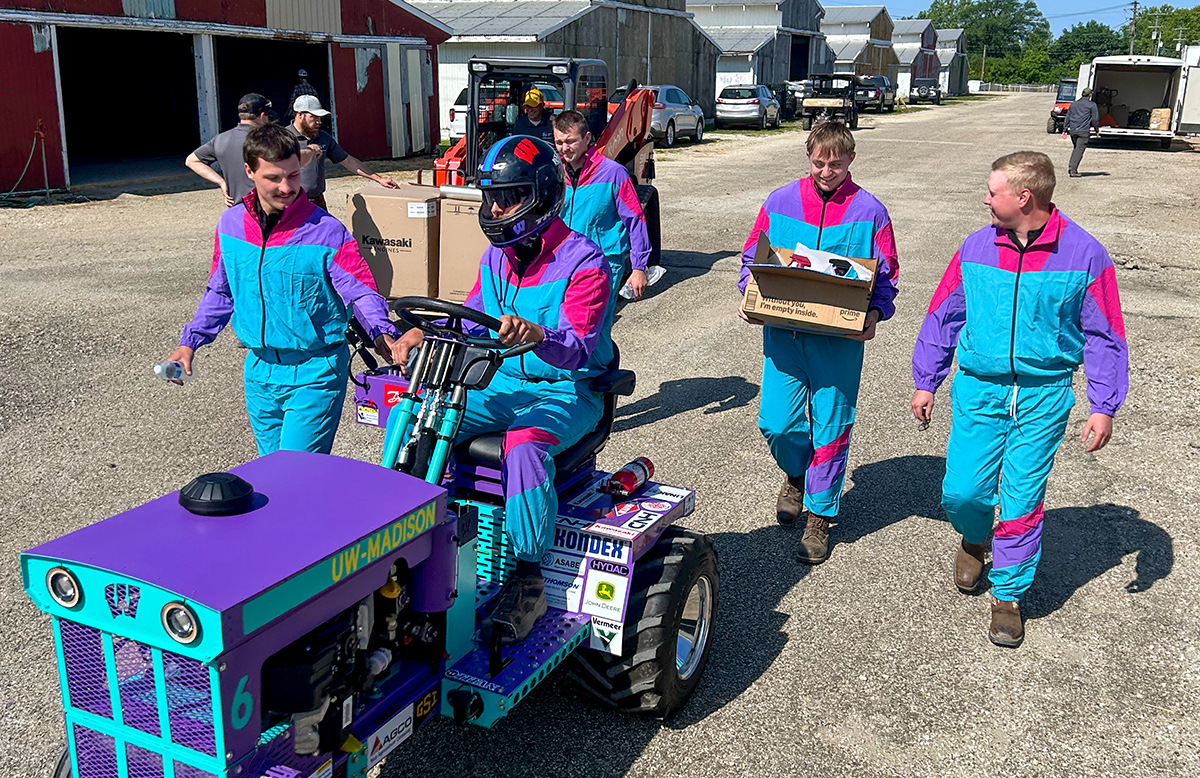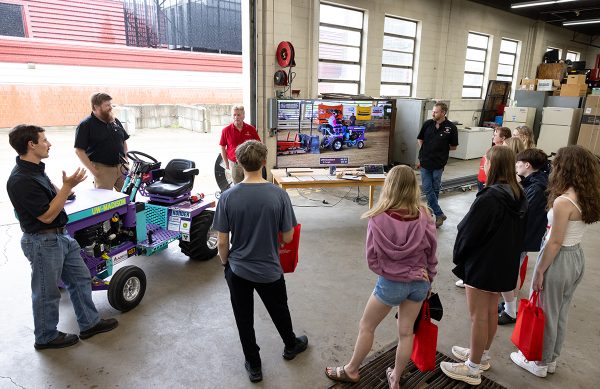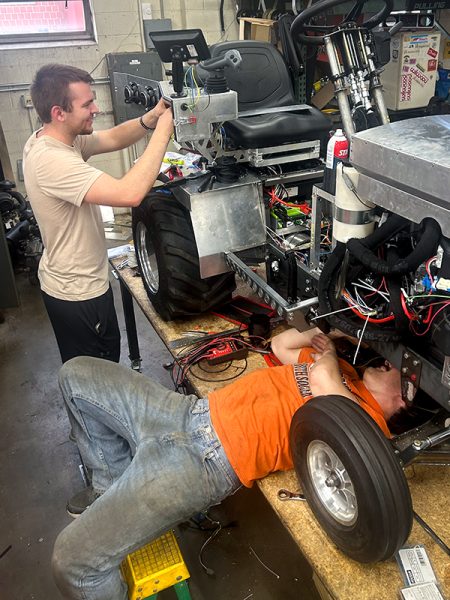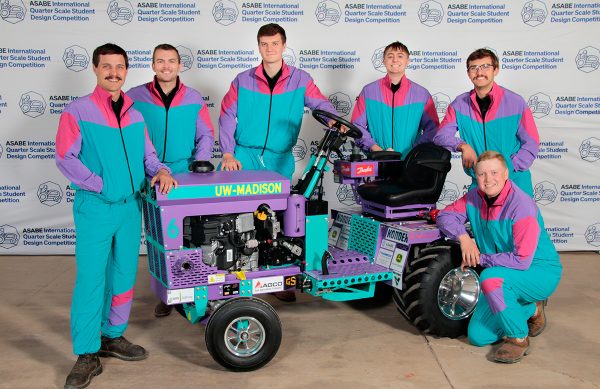Feature
How to Pull Away from the Pack with Panache
The UW Badger Pulling Team uses ingenuity, skill, and style to make its tractor design stand out at an international competition.

When undergraduate Devin Digman bought a 90s-era Kawasaki motorcycle earlier this year, he didn’t expect its purple and turquoise color scheme to bleed into other areas of his life. But the palette expanded. It became the retro body finish for a mini tractor he and the UW Badger Pulling Team entered in a major competition. The same hues also adorned their team attire. And it’s likely the crew’s flashy, tongue-in-cheek look helped them take home some impressive hardware.

The contest in question is the International Quarter-Scale Student Design Competition, hosted annually for almost three decades by the American Society of Agricultural and Biological Engineers. Each team is given an engine and tires, but they’re required to craft and submit their own tractor design and build the machine themselves. Industry experts judge entries based on innovation, manufacturability, serviceability, and other real-world factors.
For the 2025 edition, twenty-three teams from across the United States and Canada gathered in late spring in Peoria, Illinois, to put their tractors to the test. This year’s UW Badger Pulling Team — which includes biological systems engineering (BSE) majors Garrison Korn BSx’25, Kaedyn Peterson-Rucker BS’25, MSx’27, and Nathan Sorensen BSx’25; agricultural business management major Brandon Boyd BSx’27; and engineering students Jackson Barta and Digman — secured sixth place overall. They also came away with the Maneuverability Award, the Safety Award, and the Best Appearance Award.
“We are incredibly proud of their dedication and their success,” says Brian Luck, a BSE associate professor and extension specialist who serves as the team’s co-advisor. “Their overall finish and the other awards they earned against such strong international
In a nutshell, the team’s awards say this: Their tractor moved exceedingly well, it operated with above-and-beyond attention to safety, and it looked great while doing it. As one would expect, there’s a story behind the machine’s eye-catching, passé pastels. At first, the team was simply inspired to paint it to match Digman’s motorcycle (which, as a Kawasaki, coincidentally matched the brand of the tractor’s engine). But it went even further.
“It wasn’t until we actually bought the paint that our advisors took us seriously,” says Peterson-Rucker. “Then [co-advisor and BSE instructor Kody Habeck BS’08, MS’11] said, ‘If you’re committing to this, you have to get tracksuits.’ ” And they did, thanks to a surprise gift from Habeck and BSE professor emerit David Bonhoff BS’78, MS’85, PhD’88. Although the slick, nostalgic look no doubt contributed to the pulling team’s success in the appearance award, aesthetics is only skin (or paint, or fabric) deep. Many other factors related to artisanship, skill, and design came into play.

“From the precision fabrication to the meticulous wiring and hose routing, every component reflected their dedication to craftsmanship,” Habeck says. “I have no doubt this all contributed to their success, especially with the Best Appearance Award, but also in other categories.”
The Maneuverability Award recognizes the team’s exceptional engineering and design, which allowed their quarter-scale tractor to navigate a challenging course with precision and control. Their success here might be owed in part to the new controller they installed. The system, an improvement from last year’s contest entry, integrates buttons and the joystick in proximity. This helps the operator always keep a hand on the controls while accessing multiple functions.
The Safety Award underscores the team’s focused attention to safety protocols throughout the design, construction, and operation of their vehicle, which is a critical aspect in any engineering endeavor. They installed turn signals, a back-up beeper, and a horn. Perhaps the most significant safety features were the hydraulic ramps, which allow the tractor to start and stop quickly but without jerking and potentially throwing an operator out of the seat. Peterson-Rucker says they tweaked the system tirelessly to find the right balance.
For extra amenities, the team added speakers, a cup holder, and a phone charger. “These are things you don’t always think of for a tractor until you’re sitting in it and then realize, man, this would be nice,” Peterson-Rucker says.
Pulling team members accumulate a great deal of practical experience from the design and building process leading up to the competition and from the competition itself. Some of the knowledge they acquire while problem-solving — hydraulics, power systems, wiring, electrical schematics, coding — they may not have yet tackled in their courses. These skills apply beyond agricultural implements, in areas such as marine and automobile engineering.
Participants also learn the design-to-manufacturing process. “It’s thinking through how something is going to be put together as you design it,” Peterson-Rucker says.
At the competition, in addition to engaging in three performance events (tractor pull, maneuverability course, and durability course), teams must “sell” their design in a formal presentation to industry experts who play the role of a corporate management team. This includes deciding on a sales price, estimating annual sales and profit margins, and describing how the design serves the needs of a specific market. The UW Badger Pulling Team marketed their tractor for small hobby farms, orchards, and agritourism businesses. This explains the addition of the speakers, which can double as an audio system for tours.

Pulling team members also leave the competition with a burgeoning network of career contacts. Students get to mingle with judges, who represent major companies, from John Deere to Kubota to Vermeer, and more.
“For some of us, this was our third time competing, and it’s been rewarding to build our connections with the other students, judges, and industry professionals,” says Sorensen, who co-captained the team with Digman this year. “It’s also fulfilling to show our sponsors how the tractor turned out and continue building those relationships. It’s helped many of us land internships with leading agricultural companies.”
The competition pushes students to apply classroom knowledge to practical, real-world engineering challenges, Sorensen says. Knowing this, companies participate in the contest to look for students with this kind of hands-on experience.
“I think I speak for a lot of members when I say that being a part of this team has been one of the best ways to prepare for a career after school,” Sorensen says.
This article was posted in Fall 2025, Features and tagged agricultural business management, biological systems engineering, Brian Luck, quarter-scale tractor, UW Badger Pulling Team.
